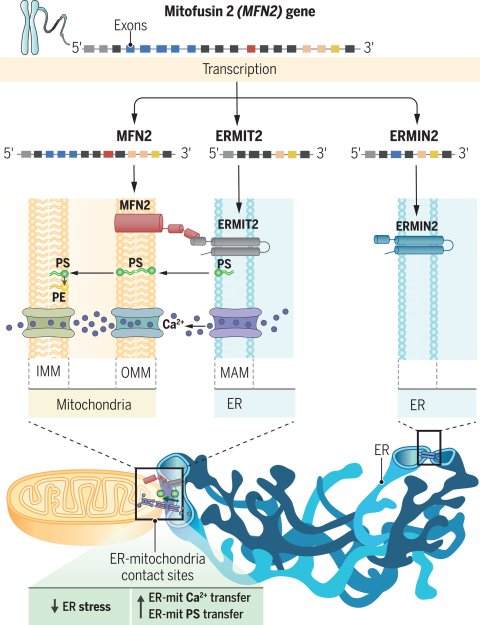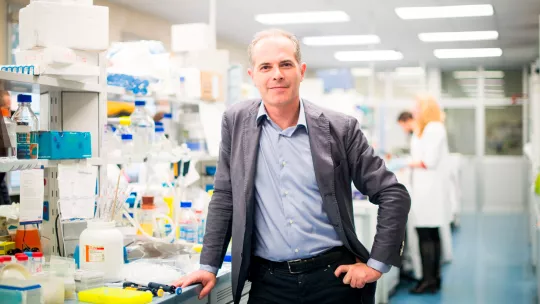Images
- Today, an international team of scientists from VIMM, the University of Padua, IRB Barcelona and the University of Barcelona have published groundbreaking findings in the journal Science.
- Their research uncovers that the mitochondrial protein Mitofusin 2 is produced in different forms and that these act as both lock and key in bridges between mitochondria, the cellular powerhouse, and the factory, the endoplasmic reticulum.
- Mitofusin 2 plays a pivotal role in the Charcot-Marie-Tooth IIA neuropathy and it is depleted in metabolic disorders such as diabetes and non-alcoholic fatty liver disease.
- This remarkable discovery paves the way for understanding cellular functionality and provides potential insights for the development of therapeutic strategies targeting these debilitating conditions.
Researchers at IRB Barcelona, the University of Barcelona (UB), VIMM, and the University of Padua unveil the key role of Mitofusin 2 cellular makeup in interconnecting organelles within cells. As essential structures with specialized functions, these organelles rely on intricate connections for seamless communication. Among these organelles, mitochondria (known as cell powerhouses) and the endoplasmic reticulum (responsible for protein and lipid synthesis) engage in vital exchanges.
A research team led by Dr. Antonio Zorzano at IRB Barcelona and the UB, Dr. Luca Scorrano at VIMM and the University of Padua and Dr. Deborah Naón, member of both teams, has now revealed the existence of distinct "variants" of the Mitofusin 2 protein, aptly named ERMIT2 and ERMIN2. These variants are generated through alternative splicing, a process where gene segments called "exons" are rearranged to generate different proteins from the same DNA sequence. Remarkably, ERMIN2 and ERMIT2, derived from the mitochondrial protein Mitofusin 2, are not located on the mitochondria themselves but instead are found on the endoplasmic reticulum.
In 2008, the group led by Dr. Luca Scorrano, Professor of Biochemistry at the Department of Biology of the University of Padua, Principal Investigator, and former Scientific Director of VIMM, uncovered that the mitochondrial protein Mitofusin 2, which is mutated in the peripheral neuropathy Charcot-Marie-Tooth IIA and reduced in metabolic disorders like diabetes and fatty liver, plays a pivotal role in facilitating these interactions. However, the partner protein on the endoplasmic reticulum remained unknown.
"Our comprehensive investigation found ERMIN2 and ERMIT2 in a wide range of human cells and tissues, including adipose tissue, muscle, and liver. These findings underscore the participation of these proteins in maintaining optimal cellular functionality," explains Dr. Antonio Zorzano, leader of the Complex Metabolic Diseases and Mitochondria laboratory at IRB Barcelona.
He co-directed the study alongside Dr. Scorrano, who says, "Our research uncovered the regulatory role of ERMIN2 in shaping the endoplasmic reticulum, while ERMIT2 interacts with Mitofusin 2, forming a bridge between mitochondria and the endoplasmic reticulum. This bridge facilitates the exchange of signals and lipids between these crucial cellular structures".

Alternative and complementary variants
Genes contain the instructions to produce specific proteins within cells. However, some genes undergo a process called "alternative splicing," where cells selectively combine gene fragments to generate multiple protein variants. This mechanism enhances the complexity and adaptability of our bodies, playing a crucial role in the functioning of living organisms.
In the case of Mitofusin 2, a mitochondrial protein, the research team has discovered two previously unknown variants named ERMIT2 and ERMIN2, which reside in the endoplasmic reticulum. ERMIT2, by interacting with Mitofusin 2, establishes the critical connection between mitochondria and the endoplasmic reticulum, while ERMIN2 regulates the structure of the latter.
"This study represents one of the rare instances where such alternative variants of mitochondrial proteins have been observed. Consequently, the interaction and mechanism of action that we describe in this study are highly innovative," notes Dr. Deborah Naón, first & co-corresponding author of the study. Dr Naón started the project during her doctoral studies at IRB and continued it during her postdoctoral stage at VIMM and University of Padova.
Metabolic and neuromuscular diseases
Facilitated by Mitofusin 2 and its variant ERMIT2, the interaction between the endoplasmic reticulum and mitochondria is vital for lipid metabolism, overall metabolic regulation, and the functioning of both mitochondria (the cell powerhouses) and the endoplasmic reticulum (the protein and lipid synthesis factory). When this interaction between organelles is compromised, a condition known as "endoplasmic reticulum stress" ensues, leading to detrimental effects on cells, tissues, and the organism.
Indeed, in 2019 Dr. Zorzano's group had discovered that impaired interaction between these two organelles contributes to non-alcoholic steatohepatitis, a severe liver complication associated with metabolic disorders. Now, the team has been able to improve liver function in models of non-alcoholic steatohepatitis by simply stimulating the production of the bridge protein ERMIT2. "The interaction between mitochondria and the endoplasmic reticulum is also altered in syndromes presenting insulin resistance, such as diabetes and obesity. Therefore, this finding presents a potential therapeutic strategy worth exploring," explains Dr. Zorzano, who is also a Professor at the Faculty of Biology of the University of Barcelona (UB) and a member of CIBERDEM.
Additionally, mutations in the Mitofusin 2 gene cause Charcot-Marie-Tooth IIa, a genetic peripheral neuropathy characterized by severe leg muscle weakness. The resulting ambulatory difficulties often necessitate wheelchair use. "The discovery of ERMIN2 and ERMIT2 opens up the possibility that disruptions in the endoplasmic reticulum and the communication of this organelle with mitochondria contribute to the clinical manifestations of this disease. If this is indeed the case, we may explore novel, targeted therapeutic strategies for this currently untreatable disorder," adds Dr. Scorrano.
“The research team's future endeavors will focus on understanding the regulation of gene "processing" to determine the production of specific protein variants. The team will also analyze the delicate balance of this process in various physiological and pathological conditions, including metabolic and neurological disorders”, reveals Dr Naón.
This groundbreaking work was conducted within the framework of projects funded by the 'la Caixa' Foundation, the Spanish Ministry of Science and Innovation, the Carlos III Health Institute, the European Research Council, the Muscular Dystrophy Association (MDA), the Italian Ministry of University and Research, and the Italian National Recovery and Resilience Plan (NRRP), Mission 4, Component 2, Investment 1.2, supported by the European Union – NextGenerationEU.
The study involved collaborations with other laboratories at IRB Barcelona, including those led by Dr. Manuel Palacín and Dr. Modesto Orozco, who played crucial roles in discussing interaction mechanisms and analysing the results. Additionally, research groups from the Institute of Neurosciences of the Autonomous University of Barcelona, Rovira i Virgili University, Joan XXIII Hospital, and Parc Sanitari Sant Joan de Déucontributed to the study.
Related article:
Splice variants of Mitofusin 2 shape the endoplasmic reticulum and tether it to mitochondria
Déborah Naón, María Isabel Hernández-Alvarez, Satoko Shinjo, Milosz Wieczor, Saska Ivanova, Olga Martins de Brito, Albert Quintana, Juan Hidalgo, Manuel Palacín, Pilar Aparicio, Juan Castellanos, Luis Lores, David Sebastián, Sonia Fernández-Veledo, Joan Vendrel, Jorge Joven, Modesto Orozco, Antonio Zorzano and Luca Scorrano
Science (2023) DOI: 10.1126/science.adh9351
About IRB Barcelona
The Institute for Research in Biomedicine (IRB Barcelona) pursues a society free of disease. To this end, it conducts multidisciplinary research of excellence to cure cancer and other diseases linked to ageing. It establishes technology transfer agreements with the pharmaceutical industry and major hospitals to bring research results closer to society, and organises a range of science outreach activities to engage the public in an open dialogue. IRB Barcelona is an international centre that hosts 400 researchers and more than 30 nationalities. Recognised as a Severo Ochoa Centre of Excellence since 2011, IRB Barcelona is a CERCA centre and member of the Barcelona Institute of Science and Technology (BIST).










